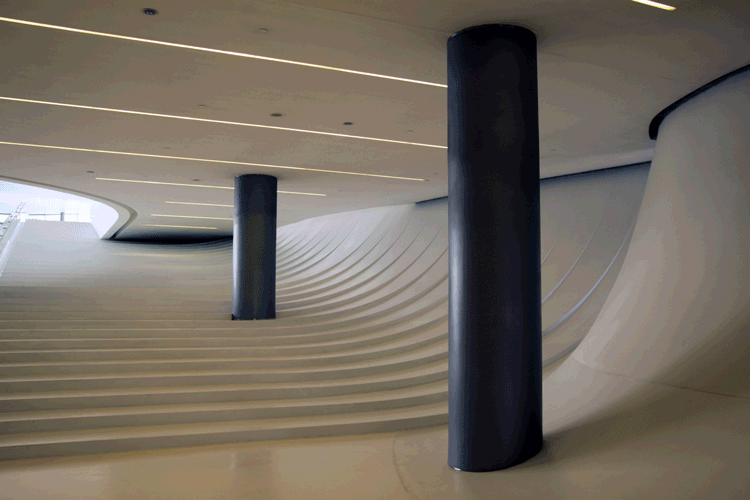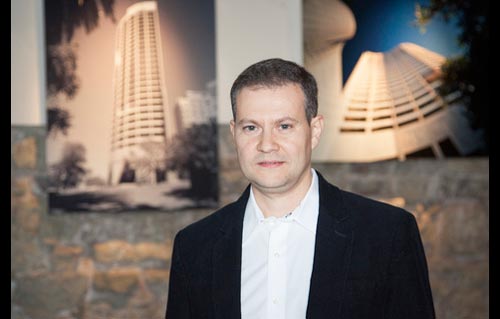-


Wonderfully
DishonestImpressions of the
Heydar Aliyev Center in Bakuby Vladimir Belogolovsky
Admirers and critics of Zaha Hadid’s work alike cannot deny her enormous influence on where architecture is headed. Her practice’s theories are tested at design schools all over the world and their work has pushed the building industry towards technical virtuosity and sophistication, says architecture critic Vladimir Belogolovsky. Here he gets under the skin of his favourite Zaha Hadid Associates building and finds himself in a love/hate dilemma.
-

The Hadid building that has impressed me most is Heydar Aliyev Cultural Center in Baku, Azerbaijan. I had the privilege of visiting the place, named after the president (father of the current president Ilham Aliyev), shortly before its official opening in 2012. This sensational structure is not easy to describe. It is also highly complex. Even the Center’s curator told me he constantly gets lost inside and finds himself discovering new ways of navigating it. Is that a good thing? Sure it is; as Renzo Piano once noted, “A museum is a place where one should lose one’s head”.
Instead of simply describing the building, I will use it as a vehicle to discuss various issues, and to talk about, to borrow Will Alsop’s phrase, “not what architecture should be, but what it could be”.
The Baku project is not unique. It explores the notion that a building is not merely an object, but an integral part of the surrounding environment, be it landscape or city. Hadid has done this time and again, and many other architects – from Frederick Kiesler to Oscar Niemeyer to UNStudio – have achieved this with no less passion and originality. Still the project in Baku stands out, as both its scale and complete integration into the land around it are breathtaking.
And the building proves another point – that we can’t dissect architecture into elements, as attempted by Rem Koolhaas at the 2014 Venice Architecture Biennale. Architecture is not merely the sum of its parts. The reason I like the Baku project is precisely because from the exterior one cannot recognise any of the familiar elements that make it look like a building: doors, windows, steps, handrails, facades, roofs – none of them – which means one cannot possibly tell what’s inside.
Heydar Aliyev Centre, 2007-12, Baku, Azerbaijan. (Photos this page and previous page: Hufton + Crow)
-

Photos: Vladimir Belogolovsky
-

Vladimir Belogolovsky (b. 1970, Odessa, Ukraine) is the founder of New York-based non-profit Intercontinental Curatorial Project with a focus on curating architectural exhibitions worldwide. He is the American correspondent for architectural journal SPEECH (Berlin) and the author of six books, including Conversations with Architects in the Age of Celebrity (DOM, 2015) and Soviet Modernism: 1955-1985 (TATLIN, 2010).
curatorialproject.com

But much as I like the building’s shell, I dislike what is within. The inside and outside of this building are completely independent projects. Once inside you start to see what is so masterfully avoided on the outside: steps, handrails, columns… In short, the familiar and predictable. You might ask, how can these fundamental elements be avoided? Well, if I knew, I would be doing my own architecture, not merely talking about it. But some of Hadid’s interiors are more successful than others in this respect. In the MAXXI in Rome, for example, nothing interrupts the overall flow of architecture that reads as a single whole. Perhaps the vast scale of the Baku building made it more challenging.
But let’s not dwell on the things that don’t work and go back outdoors to where the building is a true spectacle and a pleasure not just to the eye, but to the body as well. It constantly invites you to come into contact with it and even climb on its back. One might even imagine running over it all the way to the top. But step closer and you will realise quite quickly how challenging this would be. The building is much too steep. It kicks you back, as if it were a living creature.
But here is another question, one that the modernists used to ponder: is this building “honest”? Well, the answer is quite obviously “no”. It is not honest in the modernist sense of the word since it clearly conceals the way it is constructed. Everything within physical reach is made of “liquid” stone. Once out of reach, this material shamelessly changes to metal panels. You can’t tell though. Visually, there is no break between one material and another. The same happens on the inside – concrete and plywood flooring transition seamlessly into gypsum board walls and ceiling. Everything is a surface.
Is a dishonest building a good thing? Well, this is where I would say that architecture is not about generalisations. The very idea that an object can be “honest” is meaningless. Every case deserves its own examination. Take Eero Saarinen’s 1956 Tulip Chair for example. This futuristic design is a classic yet it is far from honest. Its base is made of metal, whereas the seat is plastic, yet one flawlessly segues into the other to make a beautiful and smooth form without acknowledging the two inherently different materials. What does this say to you? Don’t fall for clichés; follow your eye.
-
Search
-
FIND PRODUCTS
PRODUCT GROUP
- Building Materials
- Building Panels
- Building technology
- Façade
- Fittings
- Heating, Cooling, Ventilation
- Interior
- Roof
- Sanitary facilities
MANUFACTURER
- 3A Composites
- Alape
- Armstrong
- Caparol
- Eternit
- FSB
- Gira
- Hagemeister
- JUNG
- Kaldewei
- Lamberts
- Leicht
- Solarlux
- Steininger Designers
- Stiebel Eltron
- Velux
- Warema
- Wilkhahn
-
Follow Us
Tumblr
New and existing Tumblr users can connect with uncube and share our visual diary.
»I don’t mistrust reality of which I hardly know anything. I just mistrust the picture of it that our senses deliver.«
Gerhard Richter
Keyboard Shortcuts
- Supermenu
- Skip Articles
- Turn Pages
- Contents


